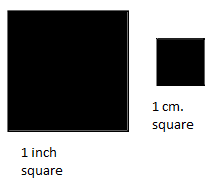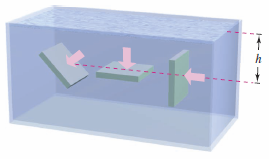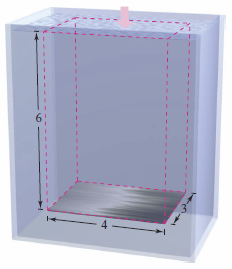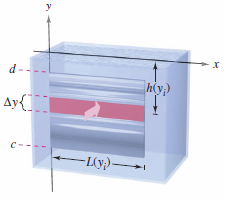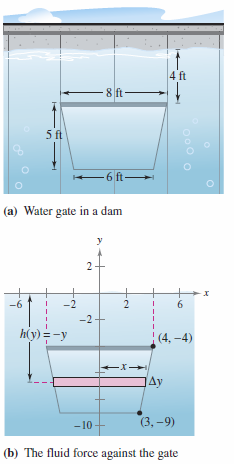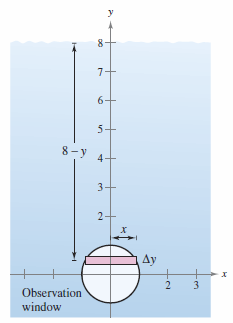Calculus II 07.07 Fluid Pressure and Fluid Force
| Previous | Calculus II 07.06 Moments Centers of Mass and Centroids |
| Next | Calculus II 08 Integration Techniques |
Contents
7.7 Fluid Pressure and Fluid Force[1][2]
- Find fluid pressure and fluid force.
|
Pressure is the force on a body's surface area. It is measured in pounds per square inch or kilograms per square centimeter. At sea level the atmospheric pressure is 15 pounds per square inch. At 30 feet below sea level the pressure is 30 pounds per square inch. |
Definition 7.7.1 Fluid Pressure
The pressure on an object at depth \(h\) in a liquid is
- $$\text{Pressure}= P = wh$$
where \(w\) is the liquid's weight-density[3] per volume unit.
Below are weight-densities for common fluids in pounds per cubic foot.
| Ethyl alcohol | 49.4 |
| Gasoline | 41.0-43.0 |
| Glycerin | 78.6 |
| Kerosene | 51.2 |
| Mercury | 849.0 |
| Seawater | 64.0 |
| Fresh Water | 62.4 |
When calculating fluid pressure, you can use an important physical law called Pascal’s Principle[4], named after the French mathematician Blaise Pascal[5]. Pascal’s Principle states that the pressure exerted by a fluid at a depth \(h\) is transmitted equally in all directions. Figure 7.7.2 show the pressure at each depth is the same for all three objects. The fluid force on a submerged horizontal surface with area \(A\) is
- $$\text{Fluid force}=F=PA=(\text{pressure})(\text{area}). $$
Example 7.7.1 Fluid Force on a Submerged Sheet
|
Find the fluid force on a rectangular metal sheet measuring 3 feet by 4 feet that is submerged in 6 feet of water, as shown in Figure 7.7.3.
Because the sheet's total area is \(A\)=(3)(4) = 12 square feet, the fluid force is
The fluid's width does not matter, only the depth matters. The fluid force is the same at the same depth in a lake or ocean. |
|
In Example 7.7.1 calculus was not needed because the entire surface was all at the same depth and thus all the pressure exerted on the body was the same. Consider a surface that is submerged vertically in a fluid. This problem requires calculus because the pressure is not constant over the surface. Consider a vertical plate that is submerged in a fluid of weight-density \(w\), as shown in Figure 7.7.4. To find the total force against one side from depth \(c\) to depth \(d\), divide the interval \([c,d]\) into \(n\) subintervals with width \(\Delta y\). Take a rectangle \(y_{i}\) with width \(\Delta y\) and length \(L(y_{i})\), where \(y_{i}\) is the \(i\)th subinterval. The force against this representative rectangle is
The force against \(n\) such rectangles is
Note that \(w\) is a constant and is factored from the summation. Taking the limit as \(\| \Delta \| \to 0 (n \to \infty ) \) produces Definition 7.7.2. |
Definition 7.7.2 Force Exerted by a Fluid
The force \(F\) exerted by a fluid with a constant weight-density \(w\)
against a submerged vertical plane region from \(y=c\) to \(y=d\) is
- $$F = w \lim_{ \| \Delta \| \to 0} \sum_{i=1}^{n} h(y_{i})L(y_{i})\Delta y $$
- $$ = w \int_{c}^{d} h(y)L(y)\: dy $$
where \(h(y)\) is the depth in the fluid at \(y\) and \(L(y)\) is the region's horizontal length at \(y\).
Example 7.7.2 Fluid Force on a Vertical Surface
|
A vertical gate in a dam is shaped like an isosceles trapezoid, 8 feet across the top and 6 feet across the bottom, with a height of 5 feet, as shown in Figure 7.7.5(a). What is the fluid force on the entire gate when the gate's top is submerged 4 feet below the water?
To find the gate's length \(L(y)\) at depth \(y\), find the equation for the gate's right side in \(y\) terms, then multiply \(x\) by 2. The line for the right side pass is anchored at points (3,-9) and (4,-4). The equation is
Figure 7.7.5(b) shows the length at \(y\) is
By integrating from \(y=-9\) to \(y=-4\) the fluid force is
|
- Find a really good Fluid Force Submarine example
Example 7.7.3 Fluid Force on a Submarine
|
A circular observation window on a submarine has a one foot radius, and the window's center is 8 feet below sea level, as shown in Figure 7.7.6. What is the fluid force on the window?
The window's horizontal width is \(2x\) and the circle formula, \(x^{2}+y^{2}=1\), can be used to solve for \(x\)
Because \(y\) spans the interval \([-1,1]\) and 64 pounds per cubic foot is the weight-density for sea water, produces the pressure formula
Breaking the integral in two makes the solution simpler.
The second integral is 0 because the integrand is odd and the integration limits are symmetric to the origin. Observing the first integral is a semicircle's area with radius 1 produces
The fluid force on the window is about 1608.5 pounds. |
Internal Links
Parent Article: Calculus II 07 Integration Applications
